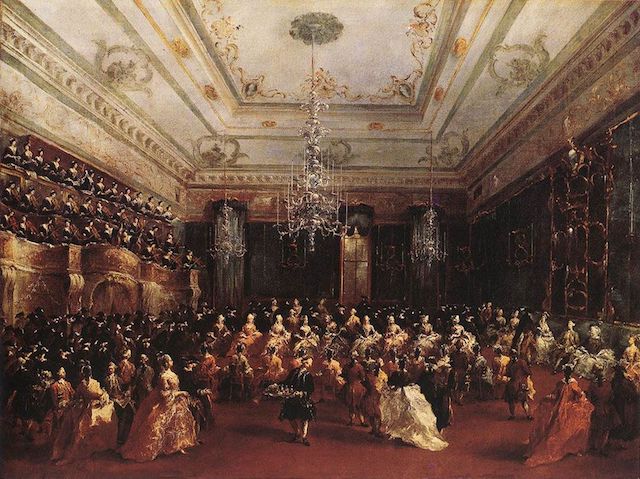
I am in the midst of reading a fascinating book – Range: Why Generalists Triumph in a Specialized World by David Epstein – and I thought one of the stories he shares would fit in nicely with my Music Monday posts.
Epstein tells the story of the figlie del coro, which means “daughters of the choir”. This was a group of musicians who drew audiences from across Europe in 17th century Venice. As Epstein puts it, they were both ground zero of a musical revolution and an oddity. Elsewhere, the instruments they played were reserved for men. One audience member noted, “They sing like angels, play the violin, the flute, the organ, the oboe, the cello, and the bassoon.” Vivaldi wrote many of his concertos with the figlie del coro in mind.
The women played behind a thin crepe hung in front of wrought-iron latticework grilles in elevated church balconies. Thus, they could be heard, but not seen.
When Jean-Jacques Rousseau finally got a chance to meet them, he was stunned with what he saw. He described one woman as “horrid”, another only had one eye, another was disfigured from smallpox. “Scarcely one of them was without some striking defect,” he noted.
As it turned out, most of the figlie had not loved easy lives. Many of their mothers had dropped them off at the Ospedale della Pieta, the “Hospital of Pity.” Many of them would never know their mothers. They were dropped off in the scaffetta, a drawer built into the outer wall of the Pieta. If the baby was small enough to fit, the Pieta would raise her.
he children were taught to read, write, to do arithmetic, as well as vocational skills. As the ospedali accrued musical instruments, music was added to the education of girls so they could play during religious ceremonies in the adjacent churches. Concerts were held every Saturday and Sunday and became a major source of funds for the institution.
The teaching system put in place was one where the older figlie taught the younger ones, and the younger ones taught the beginners.
But the focus of Epstein’s book is what was magical about the training that took place at the Ospedale that created the best musicians in Europe.
He notes it was not rigor. Formal lessons were Tuesdays, Thursdays, and Saturdays, and the figlie were free to practice on their own. However, given all of their work and chores, it only allowed for an hour of music per day.
The figlie also learned to sing and to play every instrument their institution owned. There was some practical benefit to such training. Epstein tells the story of one woman who was a world class oboe player, but when her teeth fell out in her sixties, she switched back to playing the violin, continuing to play into her seventies.
Audiences were amazed to see a virtuoso singer come out during intermission and play an instrumental solo.
The figlie were also exposed to many experimental instruments and learned how to play all of them, and to play them well.
The figlie’s skills on a vast array of instruments enabled musical experimentation to profound that it laid the foundation for the modern orchestra.
Epstein closes the story by comparing it to music education today. The massively multi-instrument approach used by the figlie goes against everything we think we know about how to get good at a skill like playing music. It goes against the deliberate practice framework, where only highly focused attempts at exactly the skill to be performed counted. Learning multiple instruments would be considered a waste of time.
The mantra today is to choose your instrument early, focus early, never waver.
But Epstein notes that a sampling period, whether it is for athletes or musicians, is not something to be eliminated in order to get a head start, it is critical for further development.
One study of students at a British boarding school found that the students classified as exceptional came from less musically active families compared to the less accomplished students, did not start playing at a younger age, were less likely to have had an instrument in the home at a very young age, had taken fewer lessons prior to entering the school, and had practiced less overall before arriving. The implication was that too many lessons at a young age may not be helpful.
What they did find though was the importance of distribution of effort across different instruments. The children identified as exceptional were the ones who had distributed their efforts evenly across three instruments. The less skilled students spent their time on the first instrument they picked up.
In other words, the exceptional students developed more along the lines of the figlie del coro.
Psychologists believe that the most common path to excellence is just this approach: first, a sampling period, often lightly structured with some lessons and a breadth of instruments and activities, followed only later by a narrowing focus, increased structure, and an explosion of practice volume.
It’s amazing to think that what many are just realizing now, was apparent 400 years ago.
*image is Francesco Guardi’s “Gala Concert in Old Procuratory for Czar’s Daughter”. The figlie del coro can be seen in the balcony.

Fascinating!
LikeLike
I agree. And the rest of Epstein’s book is filled with such fascinating stories and insights.
LikeLike